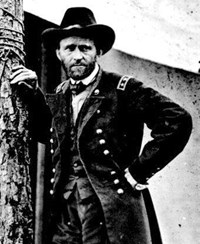- Locations: Appomattox Court House National Historical Park, Chickamauga & Chattanooga National Military Park, Fredericksburg & Spotsylvania National Military Park, General Grant National Memorial, Petersburg National Battlefield, more »

Ulysses S. Grant was one of the most important figures of 19th century America. He was a quiet family man who had worked as a farmer in St. Louis, Missouri, and as a store clerk in Galena, Illinois, before the Civil War. He rose to become President Lincoln's trusted general in charge of the entire U.S. Army during the war and later a two-term president.
- Allegheny Portage Railroad National Historic Site
Thomas Humphreys
- Locations: Allegheny Portage Railroad National Historic Site
Thomas Humphreys was a worker on the Allegheny Portage Railroad and served with the American Highlanders.
- Allegheny Portage Railroad National Historic Site
John Humphreys
- Locations: Allegheny Portage Railroad National Historic Site
John Humphreys was a worker on the Allegheny Portage Railroad and Captain of the American Highlanders.
- Allegheny Portage Railroad National Historic Site
William Humphreys
- Locations: Allegheny Portage Railroad National Historic Site
William Humphreys was an Allegheny Portage Railroad worker and member of the American Highlanders who died in the Mexican-American War at age 22.
- Palo Alto Battlefield National Historical Park
Zachary Taylor
- Palo Alto Battlefield National Historical Park
Mariano Arista
- Locations: Palo Alto Battlefield National Historical Park

Mariano Arista was an experienced Mexican officer by the time he commanded troops at the Battle of Palo Alto on May 8, 1846. Arista began his military career as an officer in the Spanish Army. The Mexican general even spent some time in the U.S. in the early 1830's. Arista returned to Mexico in 1836 and eventually rose to the rank of General of the Army of the North.
- Palo Alto Battlefield National Historical Park
Samuel Ringgold
- Locations: Palo Alto Battlefield National Historical Park

The work Ringgold put into the U.S. flying artillery would serve the U.S. Army well throughout the U.S.-Mexican War. The U.S. flying artillery saw action many times during the war and carried itself well. Ringgold’s tireless efforts to better the U.S. light artillery had a profound effect on the performance of the U.S. Army during the war and the success it enjoyed during the conflict.
- Locations: Fort Sumter and Fort Moultrie National Historical Park, Manassas National Battlefield Park, Shiloh National Military Park

P.G.T. Beauregard, the victor of the Battle for Fort Sumter and the Battle of First Manassas, later commanded Confederate armies in the Western Theater at the Battle of Shiloh and the Siege of Corinth. A vocal critic of President Jefferson Davis, he was reassigned to the defense of Charleston in 1863. After the Civil War, Beauregard experienced success in the field of business.
Lieutenant General Winfield Scott, the “Grand Old Man of the Army,” has the distinction of serving as a general longer than any other man in American history. He is remembered as a brilliant tactician, responsible for the “Anaconda Plan” that allowed the Union forces to reclaim the South during the Civil War, and the author of the primary tactical guidebook in use from 1815 through the Civil War.
Last updated: August 22, 2023



